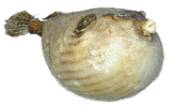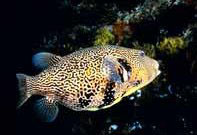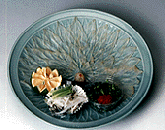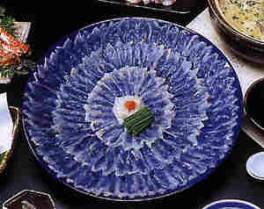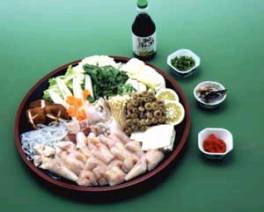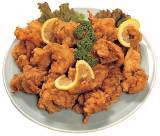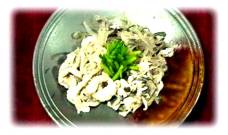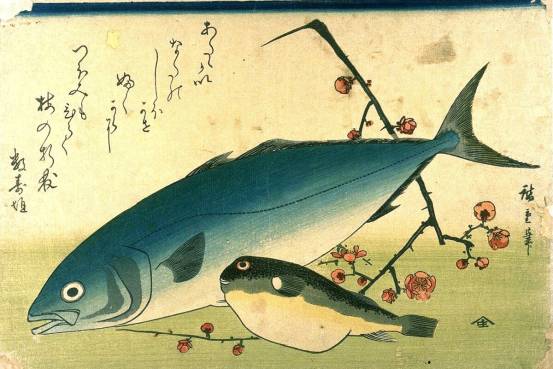
 |
Fuguby Gary Podolsky MD
Fugu is referred to as blow/globe/puffer fish since it blows its body up. The kanji (Chinese characters) used to write Fugu indicate "river pig." In western Japan, Fugu is called "fuku," which means "to blow" or "happiness ". It's reported that about 40 kinds of blowfish are caught and cultured in Japan and that 10000 tons of blowfish are consumed each year. Shimonoseki-city in Yamaguchi is known as ‘Fugu city' and supplies a large amount of Fugu. There is an old Japanese expression such that "I want to eat Fugu, but I don't want to die". Since fugu's poison can lead to instantaneous deaths of diners, only licensed chefs are allowed to prepare Fugu. They need special skills and knowledge about Fugu to be licensed. Because of strict regulations, the number of deaths is decreasing. Domestically in Canada Fugu is a rare delicacy but travelers may encounter Fugu preparations. What is Fugu?
Fugu Takifugu is a genus of pufferfish, often better known under the Japanese name Fugu .There are 25 species belonging to the Takifugu genus, which are found worldwide from about 45° latitude north to 45° latitude south, mostly in salt water (near coral reafs or shores), but sometimes also in fresh or brackish water. (There is also one species under a separate Fugu genus) Their diet consists mostly of algae, mollusks, invertebrates and sometimes crustaceans. Pufferfish defend themselves by inflating their bodies to several times normal size and by poisoning their predators. These defenses allow the fish to explore actively without much fear of being attacked. The fish is highly toxic, but despite this — or perhaps because of it — it is considered a delicacy in Japan. Pufferfish contain lethal amounts of the poison tetrodotoxin in their internal organs, especially the liver and the ovaries, but also in the skin and the testicles. Therefore, only specially licensed Fugu chefs can prepare and sell fugu to the public, and the consumption of the liver and ovaries is forbidden because they contain the highest concentration of tetrodotoxin. However, because small amounts of the poison give a special desired sensation on the tongue, these parts are considered the most delicious by some gourmets. Every year a number of people die because someone has underestimated the amount of poison in the fish.
Fugu Intoxication/Poisoning The poison paralyzes the muscles while the victim stays fully conscious, and eventually dies from respiratory failure. There is no antidote, and the standard medical approach is to try supportive therapy until the poison wears off. The fish is also featured prominently in Japanese art and culture. Fugu is also popular in Korean cuisine. Pufferfish Appearance All fishes in the tetradon family have strong teeth that may grow too long if the fish cannot consume abrasive food. Fugu can bite if provoked. Not all species are studied in detail, but the most researched takifugu is Takifugu rubripe. Takifugu rubripes breeds from March to May and lays eggs attached to rocks at a depth of around 20m. Fugu can also change color over time, becoming a darker or lighter color. This helps to aid camouflage. A very dark color may be a sign for stress or illness. The pear-shaped Takifugu , like all pufferfish, are not very good swimmers as they mainly use their pectoral fins for propulsion. Because of this they are rarely found in open water and usually stay down relatively close to the sea bed. Still, these fish are very curious and active, and in some cases even aggressive against other fugu or other fish. In the event of danger, the fish inflates itself by filling its extremely elastic stomach with water (or air when outside of the water) until the fish is almost spherical (hence the name blowfish or pufferfish). Pufferfish Inflation and Defence First, the pufferfish fills its mouth with water. Then it seals its mouth using a special valve at the bottom of its mouth. This valve flaps upward and covers the entire mouth of the fish. Next, a branchiostegal ray (a modified gill arch) pushes the water down the esophagus into the stomach. The extremely elastic stomach then expands. Depending on the species the fugu can achieve an almost perfect spherical shape. Since the fish uses seawater it does not change its buoyancy unlike a scuba diver's buoyancy vest which uses air. The fish's main lethal defense, is the neurotoxin contained in its internal visceral organs (the ovaries and the liver and to a lesser extent the intestines) and in the skin. Only minute amounts exist in the muscles and blood. This makes the fugu a lethal meal for most predators, including the occasional human.
The toxin- tetrodotoxin ( anhydrotetrodotoxin 4-epitetrodotoxin) is 1200 times deadlier than cyanide. The pufferfish does not create the poison itself. This poison is generated by the bacteria Pseudomonas and is also found in other marine animals such as the Blue-Ringed Octopus , and Cone Snails and also in some newts. These animals use the tetrodotoxin as a defence. Blue octopus bites and cone snail envenomations are medical emergancies as theyare frequently lethal. The fish obtains the bacteria by eating food containing these bacteria. Pufferfish born and grown in captivity do not accumulate tetrodotoxin until they ingest the poison-producing bacteria, often by eating tissues from a toxin-producing fish. Also, some fish are more poisonous than others. Some fish may have enough poison to kill 30 adults.
History of Culinary Fugu Fugu has been consumed in Japan for a long time, although its historic origins are unclear. Bones of fugu have been found in several shell mounds called kaizuka that date back more than 2000 years. The Tokugawa shogunate (1603-1868) prohibited the consumption of fugu in Edo and its area of influence, yet it became common again as the power of the shogunate weakened. In Western regions of Japan, where the influence of the Government was weaker and fugu was easier to obtain, various cooking methods were developed to safely eat these fish. During the Meiji Era (1867-1912) fugu was again banned in many areas of Japan. Fugu is also the only delicacy officially forbidden to the Emperor of Japan for his own safety. One rakugo , or humorous story : It tells of three men that prepared a fugu stew, but were not sure about how safe it was. To test the stew, they gave some to a beggar. When they checked the beggar later, he was still healthy, so they ate their stew. Later, they met the beggar again who told them that he was happy that they still looked healthy, so now he knew the stew was safe for him to eat. The three men had been had by the wise beggar .
Harvesting Fugu The high demand for fugu led to overfishing. Strict fishing regulations now protect fugu from being decimated. Most fugu is harvested in spring during spawning season and farmed in floating cages in the Pacific Ocean. Shionomseki is the largest wholesale market for fugu in Japan. Fugu prices rise in the fall and peak in winter, which is the best time to eat fugu, as they fatten to survive the cold. The fugu is shipped to the restaurant alive and stored in the restaurant in a large tank, usually prominently displayed. As fugu are aggressive and have sharp teeth, in captivity the mouths of fugu are often sewn shut to prevent the fish from injuring each other. Preparing Fugu Since 1958, only specially licensed chefs have been allowed to prepare and sell fugu to the public. The fugu apprentice needs a 2-3 year apprenticeship before being allowed to take an official test. The test consists of a written test, a fish identification test, and a practical test of preparing fugu and then eating it. Only 30 percent of the applicants pass. The other 70 percent do not die from poisoning but fail from a small mistake in the long and complicated procedure of preparing the dish. Due to this rigorous examination process, it is considered safe to eat the sliced fugu sold in restaurants or markets. A special knife called fugu hiki is traditionally used to slice fugu and it is usually stored carefully in a separate location from other knives. In Winnipeg there are no registered Fugu Chefs. Given the very small market for Fugu and the need to keep it fresh make its unavailability a certainty in the near future. In the US some Fugu restaurants serve fish that do not contain any toxin.
Most fugu sold nowadays comes from fish with only a small amount of toxin. Selling or serving the most toxic liver is illegal in Japan, but this "forbidden fruit" is still sometimes eaten by amateur cooks, often with fatal results. After several homeless people died from eating fugu organs that had been discarded into an insecure trashcan, restaurants in Japan are now required to store the poisonous inner organs in specially locked barrels that are later burned as hazardous waste. Prepared fugu is also often available in grocery stores which must display official documents which license them to distribute fresh fugu. Cost of Fugu A dish of fugu can easily cost ¥5000 (ca. US$50) but it can be found for as little as ¥2000 yen (ca. US$20), and a full course fugu meal can cost between ¥10,000 and ¥20,000 (ca. US$100 to US$200) or more. It's said that the most poisonous fugu, "Tora-fugu," is the most delicious. Tora-fugu is expensive and can cost over one hundred dollars at a fish market Due to the expense of fugu the fish is sliced very carefully to obtain the largest possible amount of meat without the poison.
While fugu connoisseurs love the taste and the texture of the fugu, many people actually find it rather bland and tasteless. Some professional chefs prepare the fish so that there is a minute amount of poison in the meat, giving a prickling feeling and numbness on the tongue and the lips. In several remote locations, people have devised a complex pickling process allowing them to eat the poisonous parts of the fugu. While the exact methods are kept secret, they involve long and heavy saturations in sake and salt for over three years. Nowadays, prepared fugu is sold at grocery stores and online stores and fugu is eaten at Japanese homes. Types of Fugu The most popular dish is fugu sashimi, also called Fugu sashi or tessa . It is sliced so thin that the pattern of the plate can be seen through the meat. Served with ponzu dipping sauce (a mixture of citrus juice and soy sauce). These plates are often beautifully decorated so that the removal of slices is a visual pleasure as well .
Figure 7 Fugu sashi Figure 8 Fugu chiri Fugu-chiri is made when vegetables and Fugu are simmered in konbu dashi soup in a large pot. It is served with ponzu dipping sauce. This is also called techiri , in which case the very light taste of the fish is hard to detect among the taste of the vegetables and the dip.
Fugu Kara-age is floured and deep-fried.
Figure 9 Fugu kara age Figure 10 Yubiki Fugu Hire-zake is a grilled fin put in a hot sake drink. The more poisonous testicles of the fugu can also be eaten; they contain a milky liquid and taste slightly salty. This is also considered to be an aphrodisiac. If the spikes in the skin are pulled out, the skin can also be eaten as part of a salad called yubiki . Fugu dishes are becoming more common than they used to be. Winter is the best season to eat fugu. Fugu poisoningTetrodotoxin is a very potent neurotoxin and shuts down electrical signaling in nerves by binding to the pores of sodium channel proteins in nerve cell membranes. The tetrodotoxin is very stable and is not affected by the heat of cooking . It does not cross the blood-brain barrier which leaves the victim fully conscious while paralyzing the remainder of the body. The pufferfish itself has immunity to the poison due to a mutation in the protein sequence of the sodium channel pump on the cell membranes. Toxidrome of Fugu : Almost all toxicity is caused by the ingestion of fugu, but other species of animals have been shown to produce tetrodotoxin (eg, California newt, parrot fish, blue-ringed octopus). A death from eating a California newt has been documented. The first symptoms occur 15 minutes to several hours postingestion of tetrodotoxin containing fugu. In some cases this may occur up to 20 hours after ingestion. Initial symptoms include lip and tongue paresthesias, followed by facial and extremity paresthesias and numbness. Salivation, nausea, vomiting, and diarrhea with abdominal pain develop early. Motor dysfunction with weakness, hypoventilation (this may be from the dysfunction of the central and peripheral nervous systems), and speech difficulties then develop. A rapid ascending paralysis evolves over 4-24 hours. Extremity paralysis precedes bulbar paralysis, which is followed by respiratory muscle paralysis. Deep tendon reflexes are preserved early in the course of paralysis.
Later, there is cardiac dysfunction with hypotension and bradycardia; central nervous system dysfunction (eg, coma), and seizures. In severe toxicity patients may develop deep coma, fixed non-reactive pupils, apnea, and loss of brain stem reflexes. Death can occur within 4-6 hours from respiratory muscle paralysis and respiratory failure. The fugu's poison becomes lethal as more and more muscles are paralyzed. Symptoms may include dizziness, exhaustion, headache, nausea or difficulty breathing. For 50 to 80 percent of the victims death follows within four to 24 hours. The victim remains fully conscious throughout most of the ordeal, but cannot speak or move due to paralysis, and soon also cannot breathe and subsequently asphyxiates. If the victim survives the first 24 hours, he or she usually recovers completely. Treatment of FuguOn medical examination fugu patients will have: Loss of sensory and motor neuron function (a prominent finding); ascending paralysis with respiratory depression; cyanosis occurs with respiratory failure; hypotension may occur with myocardial dysfunction; cardiac rhythm disturbances, especially bradycardia, atrioventricular (AV)–nodal block, and bundle-branch block which can be life threatening; and GI effects which are not prominent, but vomiting and abdominal tenderness may occur. There is no known antidote and treatment consists of emptying the stomach, feeding the victim activated charcoal to bind the toxin and taking standard life-support measures to keep the victim alive until the effect of the poison has worn off.Japanese toxicologists are currently working on developing an antidote to tetrodotoxin Commercially available fugu in supermarkets or restaurants is very safe and, while not unheard of, poisoning from these products are very rare. Most deaths from fugu occur when untrained people catch and prepare the fish, accidentally poisoning themselves. In some cases they even eat the highly poisonous liver on purpose as a delicacy. As not all fishes are equally poisonous so do not always lead to death, but small amounts of tetrodotxin give only the desired numbness on the lips and tongue during eating and shortly thereafter. However, in many cases this numbness of the lips is only the first step of a lethal fugu poisoning. Some sources claim that about 100 people die each year from fugu poisoning, while others sources say only 10 to 20 per year, and still others state only 1 person dies each year from fugu. This reported variation may be the result of different sequences of years being studied, as for example in 1958, the first year the preparation of fugu required a special license in Japan, 176 people died of fugu poisoning. According to the Fugu Research Institute, 50 percent of the victims were poisoned by eating the liver, 43 percent from eating the ovaries and 7 percent from eating the skin. One of the most famous victims was the famous Japanese Kabuki actor and "living national treasure" Mitsugoro Bando VIII, who died after eating four servings of fugu liver in 1975. The fugu chef serving the actor had to either refuse the request of a famous artist or break the law by serving fugu liver. Subsequently, the chef lost his license for breaking the law. There are some reports of completely paralyzed but fully conscious victims that were believed to be dead, but woke up a few days later or just before being cremated. In some parts of Japan a fugu victim is put next to his coffin for three days to verify the death. If the body does not decompose, it is not yet dead. Scientists at Nagasaki University have bred a non-toxic variety of torafugu by restricting the fish's diet. With over 4800 fish raised and found to be non-toxic, they are fairly certain that the fish's diet and digestive process are what actually produce the toxins that make it deadly. The non-toxic version is said to taste the same, but be completely safe for consumption. Fugu and Culture in Japan. The popularity of fugu in Japan is paradoxical. Fugu is a very expensive fish, has some potentially lethal side effects, and is by many people considered to have a very weak taste (although many Japanese gourmets would disagree). This would normally give people a low desire for it. But, the risk of potential death (however remote) makes it attractive. It may be that the fish would be much less popular if it were not so poisonous. In the Kansai region the slang name teppo (??) for fugu, meaning rifle or gun, is a play of words on the verb ataru (???), which can mean either to be poisoned or to be shot. In the Yamaguchi Prefecture, the pronunciation fuku is common instead of fugu . The former means good fortune whereas the latter is a homonym for disabled. The Japanese poet Yosa Buson (1716–1783) expressed some of this feeling in a famous haiku: I cannot see her tonight. I have to give her up So I will eat fugu. The Tsukiji fish market fugu association holds a service each year at the height of the fugu season, releasing hundreds of caught fugu into the polluted Sumida River. Fugu skin may be made into everyday objects like wallets or waterproof boxes. Lanterns can be made from the bodies of preserved fugu. These are seen outside of fugu restaurants, as children's toys, as folk art or as souvenirs for tourists. There is a fugu museum in Osaka. Where to Find Fugu Most Japanese cities have one or more fugu restaurants. They may be clustered together as past regulations had placed limits on where they may open their store and also the waterfront location of restaurants made it easier to have fugu delivered fresh. Takefuku is a famous restaurant specializing in fugu in the Ginza district in Tokyo. Zuboraya is a popular Osakan restaurant chain. The people of Tokyo buy Takifugu rubripes at the Tsukiji fish market — after the highly toxic liver has been removed. Few restaurants in the United States carry fugu and if it is available it does not contain any tetrodotoxin Edible FuguThe most prestigious edible species is the torafugu or Tiger Blowfish ( T. rubripes ), which is also the most poisonous. Other species are also eaten such as T. pardalis , T. vermicularis , and T. porphyreus . The following list shows which species contain body parts that can be consumed according to the Japanese Ministry of Health and Welfare. Other genera that can be consumed according to them include the puffers Lagocephalus and Sphoeroides , and the related porcupinefish of the genus Diodan . Species of the Genus Takifugu and their edibility
Pufferfish Genome project It has been observed that pufferfish DNA has less intronic and extragenic sequences than other animals. As a result, they have the smallest-known genomes yet found amongst the vertebrate animals, while containing a genetic repertoire very similar to other fishes and thus comparable to vertebrates generally. Since these genomes are relatively compact it is relatively fast and inexpensive to compile their complete sequences as has been done for two species ( Takifugu rubripes and Tetraodon nigroviridis ). The Fugu genome project is being run to compare genes with the Human Genome project because it s technically easy to accomplish and may offer insights between two radically different species.
Fugu and Travelers Travelers to Japan and Korea may encounter Fugu restaurants, which are carefully regulated and very safe. The risk from eating fugu remains from ingesting fish not prepared by professionals. Any catches of puffer fish or other tetrodotoxin bearing species should never be eaten. Travelers to foreign countries merely need to be educated so that they do not eat amateur preparations of suspect catches. ReferencesTetrodotoxin poisoning Associated With Eating Pufferfish Transported From Japan (PDF file) Morbidity and Mortality Weekly Report http://www.aegis.com/files/mmwr/1996/MM4519.PDF Theodore Benzer T oxicity, Tetrodotoxin EMedicine http://www.emedicine.com/emerg/topic576.htm Fugo Genome Project http://fugu.biology.qmul.ac.uk/ Puffer fish Lair. A website on the biology of fugu http://home.earthlink.net/%7Esnebluemoon/index.htm Personal Account of surviving a Fugu poisoning. http://www.kyoshi.or.jp/inv-haiku/routine.htm Sueyoshi´, Sueyoshi's pages on fishes .In both Japanse and english Retrieved from " http://en.wikipedia.org/wiki/Fugu " Pufferfish Genome http://www.ensembl.org/Fugu_rubripes/index.htmlMinistry of Health, Labour and Welfare of Japan http://www.mhlw.go.jp/english/index.html |
||||||||||||||||||||||||||||||||||||||||||||||||||||||||||||||||||||||||||||||||||||||||||||||||||||||||||||||||||||||||||||||
 |
